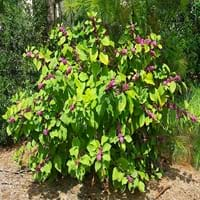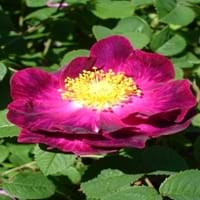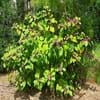Life Span
Perennial
Perennial
Type
Shrub
Flowering Plants, Ornamental Plant
Origin
Southeastern United States, South-Central United States
Europe
Types
Not Available
Beau Narcisse, Belle de Crécy, Cardinal de Richelieu, Charles de Milles, Complicata
Number of Varieties
Not Available
Habitat
bottomlands, Coastal Regions, Moist woods, pine woods, Slopes, Swamps, Thickets, Woods
gardens
USDA Hardiness Zone
6-11
8-12
Sunset Zone
3a, 3b, 4, 5, 6, 7, 8, 9, 14, 15, 16, 17, 18, 19, 20, 21, 22, 23, 24
H1, H2, 9, 13, 14, 15, 16, 17, 19, 20, 21, 22, 23, 24
Habit
Arching/Fountain-shaped
Arching/Fountain-shaped
Flower Color
Pink, Lavender
Light Pink
Flower Color Modifier
Not Available
Bicolor
Fruit Color
Purple, White
Light Pink, Light Blue, Gray Green
Leaf Color in Spring
Light Green
Green
Leaf Color in Summer
Light Green
Green, Dark Green
Leaf Color in Fall
Yellow green, Tan
Dark Green
Leaf Color in Winter
Not Available
Dark Green
Leaf Shape
Elliptic
Pinnate
Plant Season
Spring, Summer, Fall
Late Summer, Mid Summer, Summer
Sunlight
Full Sun, Partial Sun, Partial shade
Full Sun, Partial Sun, Partial shade
Type of Soil
Clay, Loam, Sand
Loam, Sand
The pH of Soil
Acidic, Neutral
Acidic, Neutral
Soil Drainage
Well drained
Well drained
Bloom Time
Early Summer, Summer, Late Summer
Indeterminate
Tolerances
Not Available
Not Available
Where to Plant?
Ground, Pot
Ground, Pot
How to Plant?
Cuttings, Seedlings
Seedlings, Stem Planting
Plant Maintenance
Medium
Medium
Watering Requirements
Medium
Requires a lot of watering, Requires regular watering
In Summer
Lots of watering
Lots of watering
In Spring
Moderate
Moderate
In Winter
Average Water
Average Water
Soil pH
Acidic, Neutral
Acidic, Neutral
Soil Type
Clay, Loam, Sand
Loam, Sand
Soil Drainage Capacity
Well drained
Well drained
Sun Exposure
Full Sun, Partial Sun, Partial shade
Full Sun, Partial Sun, Partial shade
Pruning
No need to prune
Remove damaged leaves, Remove dead branches, Remove dead leaves
Fertilizers
All-Purpose Liquid Fertilizer, fertilize in spring, Use a fertilizer ratio of 16-4-8
5-10-10 fertilizer
Pests and Diseases
Red blotch
Aphids, Black Spot, Japanese Beetles, Powdery mildew, Spider mites
Plant Tolerance
Not Available
Wet Site
Flower Petal Number
Single
Single
Fragrant Flower
Yes
Not Available
Foliage Texture
Coarse
Bold
Foliage Sheen
Matte
Glossy
Attracts
Birds, Butterflies
Bugs
Allergy
Poisonous
Asthma, contact allergic dermatitis, Rhinoconjunctivitis
Aesthetic Uses
Showy Purposes
Borders, Bouquets, Showy Purposes
Beauty Benefits
Not Available
good for lips, Improve skin tone, Moisturizing, Speed hair growth
Environmental Uses
Air purification, Food for animals, Food for birds
Air purification
Medicinal Uses
Colic, Dysentry, Fever, Malaria, Rheumatism, Stomach pain
anti-inflammatory, Antiseptic, Asthma, Dehydration, Dermatitis, Eczema, Eye Problems, Fatigue, Gallbladder Diseases, Liver problems, Sore throat, Stomach aliments, Swelling, Ulcers, Urinary tract problems
Part of Plant Used
Flowers, Root
Flowers
Other Uses
Showy Purposes, Used as Ornamental plant, Used for bedding in gardens, Used for fragrance, Used for its medicinal properties, Used for Landscaping
Can be made into a herbal tea, Cosmetics, Culinary use, Edible syrup, Making Sweet Scented Oil, Oil is used for aromatherapy, Used as essential oil, Used as Ornamental plant, Used for fragrance, Used for its medicinal properties
Used As Indoor Plant
No
Yes
Used As Outdoor Plant
Yes
Yes
Garden Design
Foundation, Mixed Border, Screening, Wind Break
Bedding Plant, Mixed Border
Botanical Name
CALLICARPA americana
Rosa gallica
Common Name
American beautyberry , French mulberry
Gallic rose, French rose, rose of Provins
In Hindi
American Beautyberry Tree
फ्रेंच गुलाब
In German
Amerikanische Schönbaum
Essig-Rose
In French
Américaine Beautyberry Arbre
Rosa gallica
In Spanish
Americana beautyberry Árbol
Rosa gallica
In Greek
American Beautyberry Δέντρο
Rosa gallica
In Portuguese
Árvore Beautyberry Americana
Rosa-rubra
In Polish
Amerykański pięknotka Drzewo
Róża francuska
In Latin
Latin Beautyberry ligno
Gallica rosa
Phylum
Magnoliophyta
Magnoliophyta
Class
Magnoliopsida
Magnoliopsida
Family
Verbenaceae
Rosaceae
Clade
Angiosperms, Asterids, Eudicots
Angiosperms, Eudicots, Rosids
Tribe
Not Available
Not Available
Subfamily
Ranunculoideae
Rosoideae
Number of Species
Not Available
Season and Care of American Beautyberry and French Rose
Season and care of American Beautyberry and French Rose is important to know. While considering everything about American Beautyberry and French Rose Care, growing season is an essential factor. American Beautyberry season is Spring, Summer and Fall and French Rose season is Spring, Summer and Fall. The type of soil for American Beautyberry is Clay, Loam, Sand and for French Rose is Loam, Sand while the PH of soil for American Beautyberry is Acidic, Neutral and for French Rose is Acidic, Neutral.
American Beautyberry and French Rose Physical Information
American Beautyberry and French Rose physical information is very important for comparison. American Beautyberry height is 182.88 cm and width 182.88 cm whereas French Rose height is 110.00 cm and width 80.00 cm. The color specification of American Beautyberry and French Rose are as follows:
American Beautyberry flower color: Pink and Lavender
American Beautyberry leaf color: Light Green
French Rose flower color: Light Pink
- French Rose leaf color: Green
Care of American Beautyberry and French Rose
Care of American Beautyberry and French Rose include pruning, fertilizers, watering etc. American Beautyberry pruning is done No need to prune and French Rose pruning is done Remove damaged leaves, Remove dead branches and Remove dead leaves. In summer American Beautyberry needs Lots of watering and in winter, it needs Average Water. Whereas, in summer French Rose needs Lots of watering and in winter, it needs Average Water.





